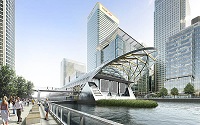1 MAY 2017
YOUR WORDS
Readers are invited to add their comments to any story. Click on the article to see and add.
BTN DISTRIBUTION
BTN also goes out by email every Sunday night at midnight (UK time). To view this edition click here.
The Business Travel News
PO Box 758
Edgware HA8 4QF
United Kingdom
info@btnews.co.uk
© 2022 Business Travel News Ltd.
Article from BTNews 1 MAY 2017
Crossrail – full by 2031?
Significant capacity restraints are looming on Crossrail west from Paddington and east from Liverpool Street by 2031, a decade after opening, the MetroRail Congress in London was told last week, writes Andrew Sharp.
 BTN asked the presenter, Tom Burton-Page, head of funding and case-making for Crossrail 2, why the system had been built too small.
BTN asked the presenter, Tom Burton-Page, head of funding and case-making for Crossrail 2, why the system had been built too small.
He responded that the major increase in London population from 8m to 10m had not been foreseen when designs were being finalised, and that his projection had shown the peak situation.
It was possible to extend the trains from nine cars to 12, and to increase frequency from 24 to 34 trains an hour, he added.
However, running 12-car trains to Heathrow would be expensive, as extending the stations there would be difficult. A train every 1.75min is technically feasible, but busy stations need to be designed to handle peak loads, with exit capacity and ventilation capacity key constraints.
Despite London mayor Sadiq Khan’s commitment to zero fare rises, London Underground managing director Mark Wild said he anticipated a 33% increase in fare revenue.
Wild showed a chart of capacity increases from new signalling and, on the Piccadilly Line, new trains, indicating capacity on the Hammersmith and City, Circle & Piccadilly Lines would go up by 60% or more: on other lines, the increases were around 20%.
OUR READERS' FINEST WORDS (All times and dates are GMT)
All comments are filtered to exclude any excesses but the Editor does not have to agree with what is being said. 100 words maximum
